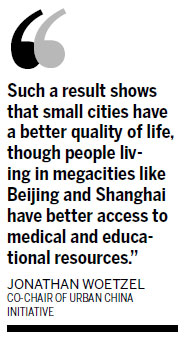Urban leaders do more to safeguard environment, conserve resources
Small and medium-sized cities are more livable than big cities such as Beijing and Shanghai gauged by their air quality, waste treatment capacity and built environment, according to newly published research by Urban China Initiative.
|
 A woman rides a bicycle on a windy day in Beijing. According to recently published research by Urban China Initiative, Beijing and Shanghai were absent from a ranking of the top 10 Chinese cities gauged by their environmental sustainability. [Photo/China Daily] |
UCI, a think tank launched by Tsinghua University, McKinsey & Co and Columbia University, gauged the sustainability of 112 major Chinese cities using 17 indicators in four categories - society, economy, environment and resources.
Beijing ranked first in sustainability thanks to its heavy investment in social welfare - including social security, education and healthcare - and its economic achievements.
The top 10 cities in overall score - including Xiamen, Fujian province, Haikou, the capital of Hainan province, Dalian in Liaoning province, and Shanghai - are all medium and large-sized cities.
|
 |
However, small and medium-sized cities are taking the lead in environmental sustainability. Both Beijing and Shanghai were absent from the top 10 in this category.
According to the research, Haikou has the best air quality, while Hefei, capital of Anhui province, took the lead in waste treatment facilities. And Xining, the capital of Qinghai province, boasts the best built environment - man-made surroundings that serve as the setting for human activity.
"Such a result shows that small cities have a better quality of life, though people living in megacities like Beijing and Shanghai have better access to medical and educational resources," said Jonathan Woetzel, co-chair of UCI, as well as a senior global director of McKinsey & Co.
Per capita income in the 112 cities ranges from 10,000 to 30,000 yuan ($1,588 to $4,763), and the study found that the higher a city's per capita income, the better the city's sustainability performance, which suggests that they have already passed the stage where income growth leads to environmental degradation.
"This is a very encouraging finding, which means many Chinese cities are now well- positioned to couple economic growth with gains in sustainability," Woetzel said.
That means that as Chinese cities become more prosperous, they can do more to protect the environment, conserve resources and promote equal access to better social services.
Beijing's high overall score shows that cities with a higher population density have an advantage in economic and service resources, according to Woetzel.
"Bigger cities have better capacity to make investments in public infrastructure such as waste treatment facilities, social security and public services," he said.
But it is also obvious that Beijing's success cannot be easily replicated considering the capital's unique administrative status.
Others argue that a closer look would raise questions over Beijing's high ranking on the country's sustainability list.
For instance, Beijing is one of the cities in China that is worst hit by water shortages, which have been worsened by its continuous urban sprawl and rapidly growing population.
According to the capital's water authority, the available per capita water usage in Beijing stands at only 100 cubic meters, 10 percent of the internationally acknowledged warning line for water scarcity of 1,000 cubic meters per capita.
Beijing has to rely on water diverted from neighboring provinces and the Yangtze River to meet its demand.
Meanwhile, Beijing's seemingly better social welfare is not shared equally among its residents considering the wealth gap and its large migrant population, said Zhou Nan, a senior official from the National Development and Reform Commission.
China's urbanization rate surpassed 50 percent for the first time in 2011, meaning that more people are living in cities than in the countryside.
And it is estimated that another 300 million people will move to cities in China by 2030, bringing the urbanization rate to 75 percent.
This means there is huge potential to drive domestic consumption if urban dwellers are guaranteed high-quality social security, education and healthcare.
Woetzel said local governments have a crucial role to play in devising a development strategy that can ensure sustainability in the coming decades.
Yin Chengzhi, an associate professor from the School of Public Management at Tsinghua University, said a new batch of development plans for some second- and third-tier cities are awaiting approval by the NDRC, and they are likely to further accelerate China's urbanize
lij@chinadaily.com.cn
